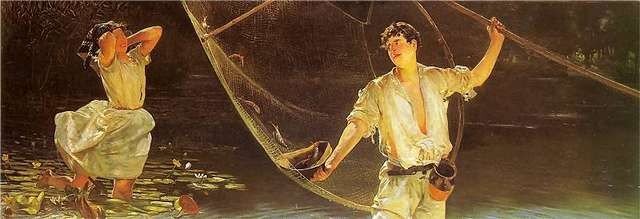Rusalka

Rusalka is generic name for water spirit, similar to mermaid in Slavic mythology. It's hard to find a reliable resources about Rusalki (plural form), because oldest written stories by Slavs date only from about eighth century.
It seems Rusalki are descendants of Bereginy, oldest known Slavic divinities, closely related to woods, nature, hunting and fertility, sometimes presented as part fish, sometimes as part bird and always as females in the role of protectors of nature, like water resources (rivers, brooks, lakes) or forests.
While in Middle Ages Bereginy slowly faded from collective memory, the lure of Rusalki stayed alive to this day. Slavs are well known by so called dvoverie, practice of keeping pagan believes and Christianity at the same time.
There are several theories about the origin and looks of Rusalki. We'll try to explore some of them and leek at some of the most famous paintings of these mysterious beautiful water spirits which inspired many great artists among painters from Eastern and Central Europe understandably dominate.
Typical Rusalka is portrayed as predator, similar to Greek Siren. She tempts young men, sometimes by her look, sometimes by her voice, sometimes only randomly calling men's names and hoping naive
victim would follow her to the shore, where she could pull him under water and keep him there until he drowns.
Just like already mentioned Bereginy, Rusalki are traditionally related with fertility (water and earth were main source of food for Slavs for many centuries after all) and some stories warn
about them as kidnappers of children or attackers of pregnant women. There are also many tales, where their presence is positive and their looks also greatly varies from one part of Europe to
another.
In general in southern parts and at warmer waters Rusalki look prettier and friendlier, while with moving to the North the become more dangerous and at cold waters their look often becomes
similar to the look of cadavers of drowned people.
This led us to the origin of Rusalki. Some believe they are supenratural representations of drowned girls, who died by handy of their husbands, parents or boyfriends. Some were killed because of
their pregnancy, what explains their desire for children and almost all of them had unsuccessful relationships with men (many girls in not so distant old times were forced in arranged marriages
with much older men, what cause many problems), what definitely explains why they like to tempt young men so much.
The painting above is work by Polish painter Jacek Malczewski (1854-1929), who made a series of next tree oil paintings below as well.
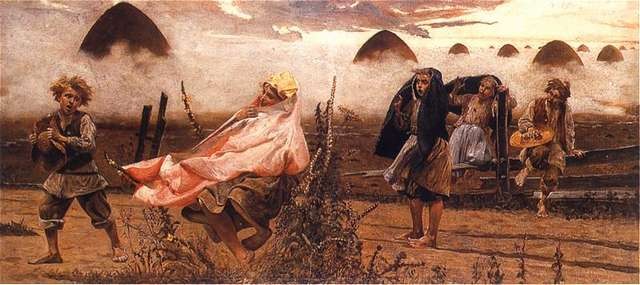
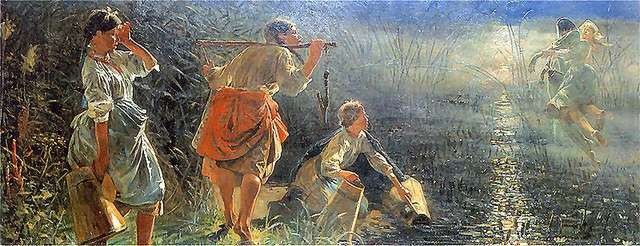
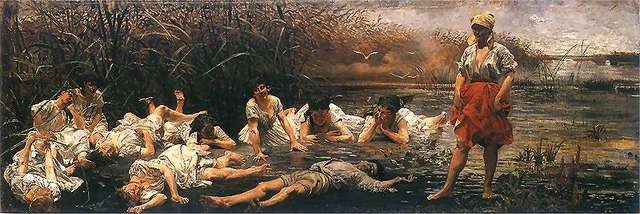

In general Rusalki are presented as beautiful, yet deadly creatures, like we can see on the painting by Mikhail Vrobel (1856-1910).
At first their hair and eyes were described as greenish and blueish as at forest nymphs, but in later stories their hair was often red. Red color is color of sin and often associated with
hell.
The origin of name Rusalka is not clear, but we may suppose it is connected with slavic word 'rus', which can mean many things, including 'of red color' and 'beautiful'. Word 'rus' is after all
root of the name Russia, which is not only largest Slavic country, but largest country in the world.
We can not find linguistic justification for this theory, but it's obvious hair plays very important role at Rusalki. They use it to seduce, they use it to entangle their victims and they are
often portrayed with combs, which suppose to give them power to stay outside of the water for as long as they wish, while the combs are safely in their possession.
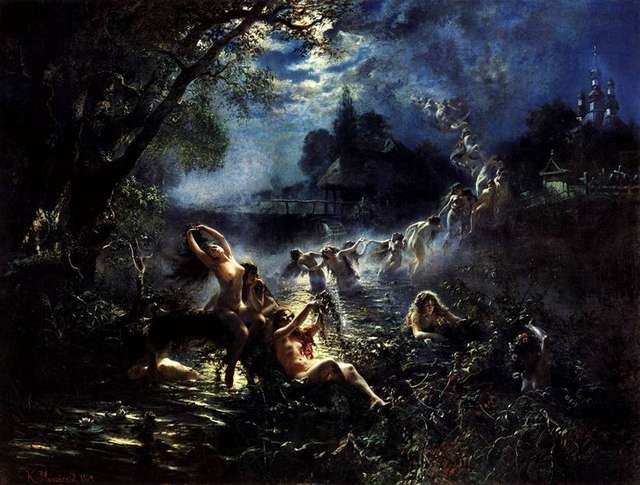
Connection of Rusalki with fertility is particularly strong. In some areas people still celebrate so called Rusalka Week, also known as Green Week. Rusalka Week is seventh or eighth after Easter
and time when the power of Rusalki suppose to be the strongest. These water nymphs come out of water and dance in the woods or singing in the trees (willows and especially birches are their
favorites), bringing water to plants. Giving life.
Some young women still offer small gifts to them in hope for getting healthy children and storytellers love to spin old tales about Rusalki, which still warn careless passengers of the dangers of
the water and young men to stay faithful to their (earthly) girlfriends.

As we can see in this drawing of Rusalka by famous Russian illustrator Ivan Bilibin (1876-1942), these creatures can also pray in treetops.
Apart from threatening individuals, Rusalki at least in some areas cause storms and hail, especially if local inhabitants don't pay right respect to them.
Among their powers is shape shifting. Some sources claim they are able only to transform into fish, frogs and similar animals closely connected to water. Another animal, related to Rusalki is a horse.
According to some folklorists they can transform in horses too, but according to others they can cause lose of livestock and horses, so be careful and don't resent to Rusalki!

 Fairy Land
The World of
Magical Creatures
Fairy Land
The World of
Magical Creatures
